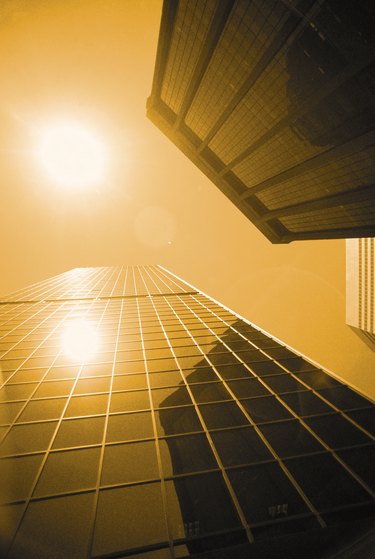
Light shelves are reflective devices that serve as overhangs inside and outside high- and low-rise offices, retrofitted structures and institutional buildings. They are usually located near window openings to intercept and reflect light evenly throughout the room. Light shelves' reflective capabilities are partly due to the materials used to minimize lighting near windows and enhance daylight quality inside buildings.
Composition
Video of the Day
Many light shelves' are made of extruded aluminum and aluminum composite material (ACM). Extruded aluminum, which is forced through a die during manufacture, is known for producing high-quality surfaces. ACM, a combination of aluminum and plastic, is known for its durability and versatility in commercial construction. The aluminum gives light shelves their conductive and lightweight properties. Additionally, aluminum and ACM provide a metallic surface that is easy to paint or coat with protective finishes. Frosted glass has also been used for light shelf materials.
Video of the Day
Other Materials and Components
Light shelves work in conjunction with other building components to produce maximum surface reflectivity. Their effectiveness is based on the ability to bounce light from the shelves' reflective surface and off ceilings to evenly disperse light indoors. The Wentworth Institute of Technology (WIT) recommends that ceilings and walls be painted white or in light colors to improve light dispersion throughout the room. Other materials and components used in light reflection include paint finishes and office partitions or cubicles. For example, paint with rougher textures help scatter light around the room. Partitions and cubicles positioned at low heights facilitate rather than block or absorb sunlight being reflected off the shelves.
Installation and Maintenance
Light shelves should be used in cold climates and in regions in the Northern Hemisphere, according to WIT. Because they facilitate solar heat gain inside buildings, light shelves perform best in mild rather than hot climates. Since light shelf materials are meant to be highly reflective, WIT suggests installation along the southern and western facades of buildings to produce optimal results. To take maximum advantage of the sun's angle throughout the day, light shelves' surface should also be cleared of dust and other debris to maintain high performance and uniform illumination.
Benefits
While light shelves improve the quality and distribution of natural lighting in buildings, they also conserve energy. A U.S. Army Corps of Engineers MILCON publication states that light shelves installed along exterior walls help save between 10 and 40 watts of electricity. Energy savings are estimated based on lighting extending 10 to 20 feet into indoor spaces. Moreover, light shelves' reflective materials help diffuse indoor glare from sunlight. The combination of natural lighting and agreeable room temperatures enhances occupant comfort and as well as worker productivity.